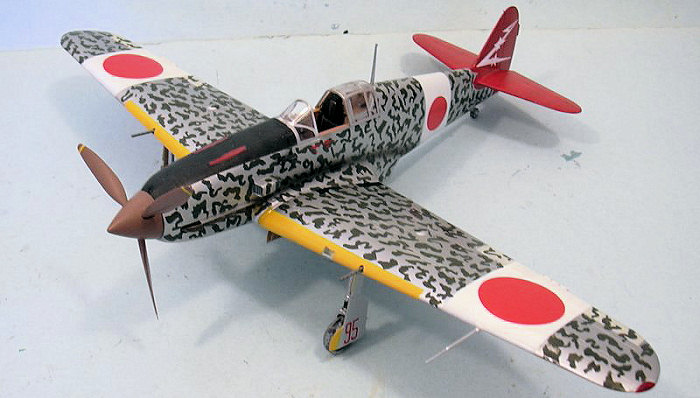
Hasegawa 1/32 Ki-61-I hei 'Hein'
| KIT #: | 08078 |
| PRICE: | 4200 yen |
| DECALS: | Three options |
| REVIEWER: | Tom Cleaver |
| NOTES: |

| HISTORY |
The Japanese Army Air Force was extremely conservative in its view of what constituted a good fighter. As a result, when the JAAF entered the Pacific War, its main fighter was the obsolete (by Western standards) Nakajima Ki.27 (Nate), and its newest fighter - which only equipped one fighter Sentai - was the already-obsolescent Ki.43 Hayabusa (Oscar). While both fighters were highly-maneuverable and could give Western opponents fits, an Allied fighter pilot had only to keep his speed up and avoid high-G "dogfight" maneuvering in the horizontal plane to neutralize the good qualities of either fighter, with the Allied pilot able to break off combat at will through use of superior speed overall, and higher diving speeds. One good hit by the heavier firepower of the western fighter was usually enough to blow either of these fighters apart, due to their light construction and lack of armor.
The first JAAF fighter that met Western standards to see combat in the Pacific
War was the Kawasaki Ki.61, known officially as the Type 3 Model 1 land-based
interceptor. The Japanese name was Hien - which translates as "Flying
Swallow" - while the Allied code name was "Tony." First encountered over New
Guinea in 1943, where it was initially thought by the Allies to be perhaps a
development of either the Messerschmitt Bf-109 or the Macchi C.202 (hence the
code name), the Ki.61 gave a good account of
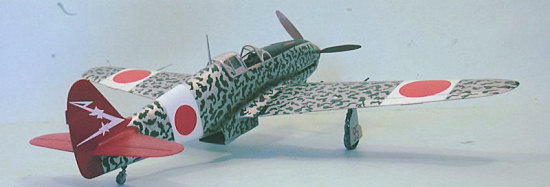 itself throughout the remainder
of the Pacific War. It was considered by its opponents to be one of the most
dangerous Japanese fighters, and very difficult to shoot down.
itself throughout the remainder
of the Pacific War. It was considered by its opponents to be one of the most
dangerous Japanese fighters, and very difficult to shoot down.
Kawasaki had acquired the manufacturing rights to the new series of Daimler-Benz aircraft engines in 1937, though it would not be until 1940 that the JAAF would take advantage of this fact. In February 1940, Kawasaki received development contracts for two fighter designs to be powered by the Daimler-Benz DB601A: the Ki.60 and Ki.61. Of the two, the Ki.60 was a very straightforward attempt to emulate European design standards, with the result being a "heavy" fighter with a top speed of 350 mph, which was the fastest of any JAAF aircraft to date when it first flew in March 1941 with a German DB601A engine. The Ki.60 was, however, ahead of its time so far as the JAAF was concerned, and further development was given over to the lighter, more "Japanese," Ki.61.
Kawasaki had simultaneously been working on the Ha.40, an indigenous development of the DB601A that was lighter than the original German engine, and rated at 1,175 h.p. Unfortunately, this lightness of design would ultimately be the downfall of the engine, because it could not stand up to prolonged operational use, in addition to being subject to poor quality control in production.
The Ha.40 powered the Ki.61 prototype which first flew in December, 1941. In early tests the aircraft achieved a top speed of 368 mph, though this would never be matched by production versions until the introduction of the higher-powered Ki.61-II in 1943. Twelve additional prototypes were built, and were flown in comparison with captured U.S. P-40Es from the Philippines and a German Bf-109E - the Ki.61 was superior to both.
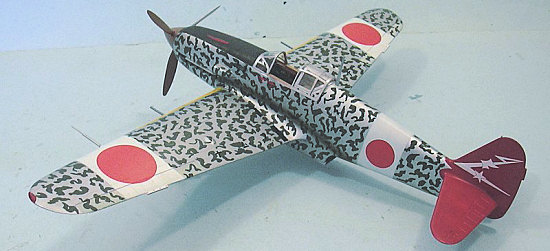 The first production
Ki.61 was powered by the production version of the Ha.40, the Type 2 Ha.60/22,
rated at 1,100 hp and providing a top speed of 348 mph. The initial production
version, the Model The Ki.61-I Kou, was armed with two 7.62mm machine
guns in the fuselage, and two 12.7mm weapons in the wings. This was followed
by the Ki. 61-I Otsu, which was armed with four 12mm machine guns.
The first production
Ki.61 was powered by the production version of the Ha.40, the Type 2 Ha.60/22,
rated at 1,100 hp and providing a top speed of 348 mph. The initial production
version, the Model The Ki.61-I Kou, was armed with two 7.62mm machine
guns in the fuselage, and two 12.7mm weapons in the wings. This was followed
by the Ki. 61-I Otsu, which was armed with four 12mm machine guns.
In August, 1943, production switched to the Ki.61-I Hei, in which the 12.7mm wing guns were replaced by German 20mm MG 151 Mauser cannon. Only 800 of these weapons were obtained from Germany, limiting production of the Hei to 400 aircraft. The next production version, the Ki.61-I Tei, replaced the previous armament with 2 Ho5 20mm cannon in the fuselage, which was lengthened 8 inches between the cockpit and the engine firewall to provide room for the larger weapons, with 12mm machine guns in the wings. Total production of all variants of the Ki-61-I was 2,654.
After initially appearing in New Guinea, the Ki.61 next appeared over Rabaul. This was followed by deployment to China, where it proved more than a match for the P-40s of the 23rd Fighter Group, which in turn led to expedited equipment of the 23rd FG with the P-51 Mustang in early 1944. The Ki.61 also equipped units based in the Philippines in 1944.
Allied fighter pilots respected the Ki.61, which provided better armor protection for the pilot and engine than other Japanese fighters, while providing excellent maneuverability and a diving speed that allowed it to keep up with any Allied fighter that attempted to disengage by diving.
The appearance of the B-29 in significant numbers over Japan, beginning in November 1944, led to the return of as many Ki.61-equipped units to the Home Islands as possible. In limited combat against the China-based B-29s in the summer of 1944, the Ki.61 had proven to be one of the few Japanese fighters capable of meeting the B-29 at altitudes over 30,000 feet.
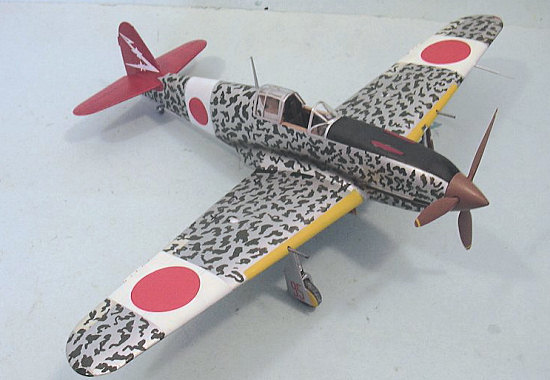 Unfortunately for the
Ki.61, the Ha.40 engine became an ever-increasing source of trouble, varying
greatly in rated power between specific engines due to poor production quality
control. The designed-in lightness of the engine led to main-bearing failures
and oil system faults. By the Spring of 1944, production of the Ki.61 was
lagging due to the fact that production of the Ha.40 had been cut back in an
attempt to restore production quality. Production of the engine stalled out
completely in the summer of 1944 due to a severe shortage of cylinder blocks and
crankcases. Further development of the Ki.61 in the Ki.61-II and -III versions
with a higher-powered development of the Ha.40 - the Ha.140 - were completely
unsuccessful due to the failure of the engine, though when the engine worked
properly the Ki.61-II was the only Japanese interceptor capable of maintaining
combat formation up to 33,000 feet.
Unfortunately for the
Ki.61, the Ha.40 engine became an ever-increasing source of trouble, varying
greatly in rated power between specific engines due to poor production quality
control. The designed-in lightness of the engine led to main-bearing failures
and oil system faults. By the Spring of 1944, production of the Ki.61 was
lagging due to the fact that production of the Ha.40 had been cut back in an
attempt to restore production quality. Production of the engine stalled out
completely in the summer of 1944 due to a severe shortage of cylinder blocks and
crankcases. Further development of the Ki.61 in the Ki.61-II and -III versions
with a higher-powered development of the Ha.40 - the Ha.140 - were completely
unsuccessful due to the failure of the engine, though when the engine worked
properly the Ki.61-II was the only Japanese interceptor capable of maintaining
combat formation up to 33,000 feet.
The best-known unit to operate the Ki.61-I-KAI was the 244th Sentai. Based at Chofu, a suburb of Tokyo, their efforts were guaranteed heavy coverage in the national media.
The 244th Hikoh Sentai was established by redesignating the 144th Hikoh Sentai on April 15, 1942. The 144th had been a small homeland fighter unit with two Chutai equipped with 19 Type 97 Fighter, Ki-27 fighters, under the command of the 17th Hikohdan (air brigade). After the Doolittle Raid on April 18, 1942, the 244th Sentai became a 3-Chutai air-defense unit operating from Chofu Air Base just west of Tokyo in May, 1944, equipped with the Ki.61 in all three versions. Until the B-29 attacks began in November, 1944, the 244th Sentai was involved in training, patrols, and preparations for the battle all knew was coming. Training for high-altitude interceptions revealed that with a full load of fuel, armament, and protection, the Ki.61 could barely reach the altitudes it was already known the B-29 operated at. The Sentai began a program to lighten their aircraft, stripping out armor, removing the lighter-caliber weapons to leave the airplane equipped with two 20mm cannon, and removing the system for drop tanks.
Ramming attacks were planned following the first successful such attack in
August 1944, when Shigeo Nobe from the 4th Hikoh Sentai intentionally
sliced into a B-29 during a mission flown from China against the steel factories
at Yahata, in Kyushu. Many individual pilots decided it would be the only way
to bring success. On November 7, 1944, the commanding officer of the
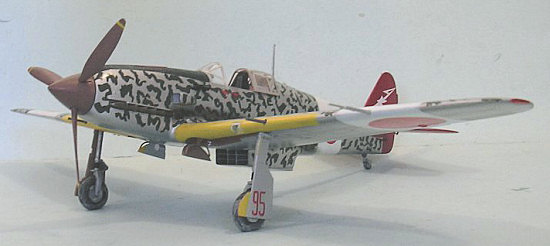 10th Hikohdan asked the men
of the units under his command to form ramming attack flights, using aircraft
specially stripped of armament and armor, making controlled collisions with the
B-29s. While these were not specifically Kamikaze attacks, since the pilot was
supposed to bail out once the collision was certain, the pilots remained with
the ramming unit until they were wounded so badly that they could no longer fly
or were killed.
10th Hikohdan asked the men
of the units under his command to form ramming attack flights, using aircraft
specially stripped of armament and armor, making controlled collisions with the
B-29s. While these were not specifically Kamikaze attacks, since the pilot was
supposed to bail out once the collision was certain, the pilots remained with
the ramming unit until they were wounded so badly that they could no longer fly
or were killed.
Led by Captain Teruhiko Kobayashi, the youngest Sentai commander in the J.A.A.F., the 244th Sentai became known to the 20th Air Force B-29 crews for their terrifying ramming attacks, and eventually was the top-scoring Japanese unit against the B-29s. The unit was the best-known home defense unit, due to the fact it was based right outside Tokyo, where it became a darling of the Japanese media in the final actions of the war.
| THE KIT |
To
my mind, the Ki.61 Hien is the best-looking Japanese fighter of the
Pacific War, from a strictly-aesthetic point of view, with its narrow fuselage,
pointed nose, and graceful wings. Tamiya produced a 1/50 Ki.61 in the late
1960s, but this suffered major fuselage outline irregularities due to the fact
it was designed to take an electric motor inside, which additionally meant that
interior cockpit detail was non-existant. Otaki released a Ki.61 in the early
1970s in 1/48 scale, which is accurate and can still be found, though it has a
bit more recessed surface detail - in the form of rivets - than one might care
for today, as well as a cockpit in need of detailing. Hasegawa first released a
Ki.61 in 1/72 scale in 1974, which was the first accurate kit of this airplane
released by any 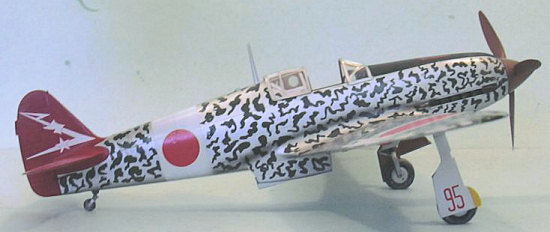 manufacturer,
with very nice (for the time) cockpit detail. This kit is still in production
nearly 35 years later, and can be safely recommended to any modeler who builds
in the smaller scale.
manufacturer,
with very nice (for the time) cockpit detail. This kit is still in production
nearly 35 years later, and can be safely recommended to any modeler who builds
in the smaller scale.
Hasegawa first released the Ki.61 in 1/48 in 1994. There have been several limited releases of the kit with various markings in the years since. This new Ki.61-I-KAI, which was a surprise announcement at the recent Shizuoka Model Show in Tokyo last month, is the first release in 1/32 scale by a mainstream manufacturer since Revell released their Tony 30 years ago. There is also a considerably more expensive resin kit that has been released by MDC, which suffered from complaints about quality control of the major parts by its initial buyers I am told.
This new kit is highly reminiscent of the earlier 1/48 kits. It is accurate, with thin trailing edges on all flying surfaces, and has a cockpit that is detailed sufficiently out of the box that most modelers will not feel an overpowering need for a resin replacement - though I am sure at least MDC will be offering one if only to recoup the losses on their full kit, orders for which stopped completely within days of the announcement by Hasegawa of this kit. For me, the one negative for all the earlier kits in smaller scales has been that the canopy is one-piece and cannot be displayed open without major surgery or replacement by a vacuform canopy. Fortunately, this kit provides the option of either a closed or open canopy.
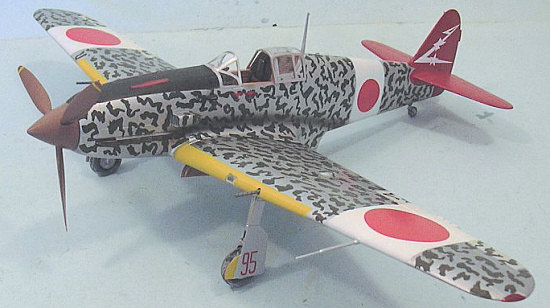 Decals are the new style
Hasegawa type, with white areas that really are, and with sufficient opacity to
go over surface paint without markings like blotches showing through. The kit
supplies markings for the Ki.61-I flown by Captain Kobayashi on January 27,
1945, when he scored his second B-29 kill by ramming his opponent. This is not
the far better-known (because it was more widely photographed) Ki.61 with blue
stripe markings and 12 B-29 kills under the cockpit that most people associate
with Kobayashi, which was a Ki.61-I Tei. There is an additional 244th
Sentai rudder marking in red, which would be correct for an overall-silver
airplane, and which might be the Ki.61 flown by Kobayashi when he shot down his
first B-29 in November 1944. The other two markings options are for an
overall-silver Ki.61 of the 18th Sentai flown by Lieutenant
Mitsuo Koyake in January 1945 that has a very colorful red and white sunburst on
the rudder, and an overall-camouflaged Ki.61 of the 39th Chutai
in March 1945. Both of these airplanes are B-29 “killers” from the victory
markings they carry.
Decals are the new style
Hasegawa type, with white areas that really are, and with sufficient opacity to
go over surface paint without markings like blotches showing through. The kit
supplies markings for the Ki.61-I flown by Captain Kobayashi on January 27,
1945, when he scored his second B-29 kill by ramming his opponent. This is not
the far better-known (because it was more widely photographed) Ki.61 with blue
stripe markings and 12 B-29 kills under the cockpit that most people associate
with Kobayashi, which was a Ki.61-I Tei. There is an additional 244th
Sentai rudder marking in red, which would be correct for an overall-silver
airplane, and which might be the Ki.61 flown by Kobayashi when he shot down his
first B-29 in November 1944. The other two markings options are for an
overall-silver Ki.61 of the 18th Sentai flown by Lieutenant
Mitsuo Koyake in January 1945 that has a very colorful red and white sunburst on
the rudder, and an overall-camouflaged Ki.61 of the 39th Chutai
in March 1945. Both of these airplanes are B-29 “killers” from the victory
markings they carry.
| CONSTRUCTION |
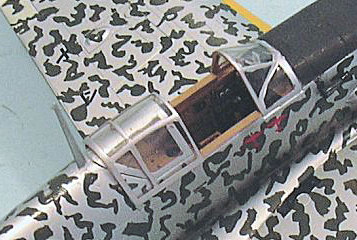 Construction of this kit
is the essence of simplicity: follow the instructions and you will find no
problems to deal with.
Construction of this kit
is the essence of simplicity: follow the instructions and you will find no
problems to deal with.
I started by painting the cockpit with Xtracrylix RLM 79 “Sandy Brown,” which is considered a good match to Kawasaki Tan. The only departure I made from doing this OOB was to use the new Eduard photoetch 1/32 JAAF seatbelts, which really add the final bit to a good cockpit.
The fuselage went together without problem. The kit is designed like the 109s, with an internal spar sub assembly that guarantees the wings will be installed at the right angle, and which portends the possibility of a future release of a Ki.100, since having the wings separate this way gets rid of the problem of introducing the Ki.100 fuselage which is deeper in cross section than the Ki.61. The wings and horizontal stabs were assembled and attached to the fuselage, and I was ready to go to the paint shop.
| COLORS & MARKINGS |
Painting:
I
painted the fabric control surfaces with Tamiya JAAF Green-Grey, the upper
cowling with Tamiya NATO Black, and the tail
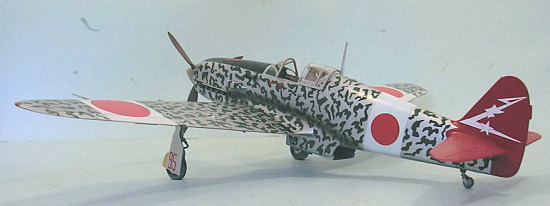 with Tamiya Flat Red. The wheel
wells and interior of the gear doors were painted Xtracrylix RLM 79, and the
wing leading edges were painted Xtracrylix RAF Trainer Yellow. The Home Defense
“bandages” were painted with Tamiya Flat White. When dry, all this was masked
off and the model was painted with SNJ Aluminum. I finished off by
hand-painting the small green splotches, as shown in a photo of a 244th
Sentai Ki.61-I that appeared to have been hand-painted (as most were). I did
this with thinned Xtracrylix RAF Dark Green with a 0000-brush. Xtracrylix goes
on as smoothly brush-painted as it does airbrushed. The spinner and prop were
painted with Xtracrylix “Signalbraun.”
with Tamiya Flat Red. The wheel
wells and interior of the gear doors were painted Xtracrylix RLM 79, and the
wing leading edges were painted Xtracrylix RAF Trainer Yellow. The Home Defense
“bandages” were painted with Tamiya Flat White. When dry, all this was masked
off and the model was painted with SNJ Aluminum. I finished off by
hand-painting the small green splotches, as shown in a photo of a 244th
Sentai Ki.61-I that appeared to have been hand-painted (as most were). I did
this with thinned Xtracrylix RAF Dark Green with a 0000-brush. Xtracrylix goes
on as smoothly brush-painted as it does airbrushed. The spinner and prop were
painted with Xtracrylix “Signalbraun.”
Decals:
I used the kit decals for the national insignia, 244th Sentai tail insignia, and the stencils.
| FINAL BITS |
I unmasked the canopy and attached the sliding canopy in the open position. I then attached the venturi tube and finished off by attaching the landing gear and pitot tube. The airplanes of the 244th were well-maintained, so the only weathering I did was to apply exhaust stains with Tamiya “Smoke.”
| CONCLUSIONS |
This is a kit that really is “fool-proof” so long as you read the instructions. The kit design is even more assembly-friendly than anything done by Tamiya. Given that the exchange rate is where it is right now, which gives the kit a price around US$36, it’s a bargain. With the possibility of aftermarket decals for the many units that flew the Ki.61 in a variety of camouflage finishes, this is as close to “Luftwaffe modeling” as one can get as regards interesting markings and camouflage. The model looks great sitting next to the Ki.84.
July 2007
Copyright ModelingMadness.com. All rights reserved. No reproduction in part or in whole without express permission.
If you would like your product reviewed fairly and fairly quickly, please contact the editor or see other details in the Note to Contributors.